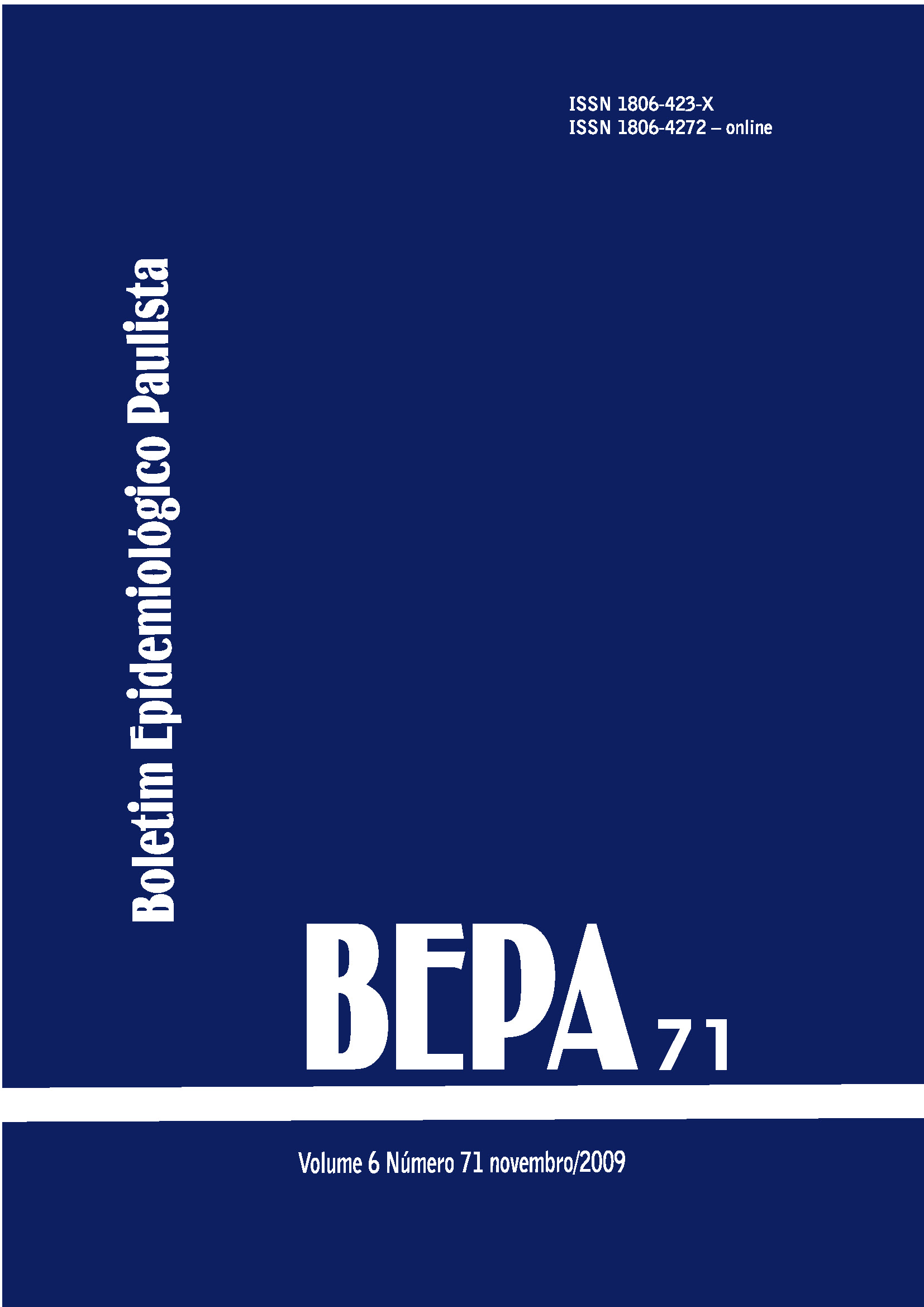Abstract
Brazil has an extensive endemic area to Sylvatic Yellow Fever (SYF), where annually cases of disease occurs in non-vaccinated individuals that have contact with natural cycle. In Northwest region of São Paulo State (SPS), the immunization against Yellow Fever (YF) is recommended as routine, once that has sporadic Virus circulation in the region. Between February and April of 2009 the SPS registered 25 cases of SYF, in five cities located on YF non-recommended immunization area. Buri city was the last city included, being important make a Vaccine Coverage survey and analyze the possible occurrence of related adverse vaccine events. The expected prevalence of light pos-vaccination symptoms is very variable, existing few reference studies. A semi-structured questioner was applied, in Urban and Rural Zones (UZ and RZ) of Buri city, in April 26-29 of 2009. In UZ was used a Simple Random Sample of 218 individuals. In RZ it was sampled 256 individuals who live in seven reference neighborhoods. The Vaccine Coverage was 94,9% in UZ and 98,4% in RZ, being inferior to Minister of Health recommendation (100%). It was observed a prevalence of at least one pos-vaccination symptom of 38,6% in UZ and 36,9% in RZ. The prevalence of the symptoms: fever (UZ = 15,6% and RZ = 14,3%), headache (UZ = 20,6% and RZ = 27,0%) and myalgia (UZ = 26,1% and RZ = 24,6%) were higher than expected. It was observed high prevalence of diarrhea (UZ = 6,9% and RZ = 12,3%) and vomit (UZ = 3,2% and RZ = 10,7%), considered non-expected symptoms. Thus it's important to evaluate gastrointestinal symptoms as possible adverse events pos-vaccination with the 17DD YF vaccine and make more studies about light pos-vaccination events with the YF vaccine in different populations, in real situations.
References
Ministério da Saúde, Secretaria de Vigilância em Saúde. Guia de vigilância epidemiológica. Brasília (DF): Ministério da Saúde; 2005.
Centro de Vigilância Epidemiológica “Prof. Alexandre Vranjac” - CVE. Casos de febre amarela silvestre em residentes do Estado de São Paulo, 2007–2008. BEPA [boletim na internet]. 2008 jul. Disponível em: http://www.cve.saude.sp.gov.br/agencia/ bepa55_famarela.htm.
Centro de Vigilância Epidemiológica “Prof. Alexandre Vranjac” - CVE. Febre amarela: situação epidemiológica e ampliação da área de recomendação de vacinação no Estado de São Paulo. BEPA [boletim na internet]. 2009 jan. Disponível em: http://www.cve.saude.sp.gov.br/ agencia/bepa61_famarela.htm.
Centro de Vigilância Epidemiológica “Prof. Alexandre Vranjac” - CVE. Febre amarela silvestre no Estado de São Paulo, 2009. BEPA [boletim na internet]. 2009 mar. Disponível em: http:// www.cve.saude.sp.gov.br/agencia/ bepa63_famarela.htm.
Ministério da Saúde. Programa Nacional de Imunizações (PNI). Manual de Eventos Adversos Pós-Vacina. Brasília (DF): Ministério da Saúde; 2005.
Huhn GD, Brown J, Perea W, Berthe A, Otero H, Libeau G, et al. Vaccination coverage survey versus administrative data in the assessment of mass yellow fever immunization in internally displaced persons, Liberia, 2004. Vaccine. 2006;24(6):730-7.
Adhiyaman V, Oke A, Cefai C. Effects of yellow fever vaccination. Lancet. 2001;358:1907-8.
Monath TP, McCarthy K, Bedford P, Johnson CT, Nichols R, Yoksan S, et al. Clinical proof of principle for ChimeriVax™: recombinant live, attenuated vaccines against flavivirus infections. Vaccine. 2002;15:1004-18.
Monath TP. Yellow fever vaccine. Travelers' vaccines. Jong EC, Zuckerman JN. Edt PMPH-USA; 2004. p. 440.
Camacho Lab & Collaborative Group for the Study of Yellow Fever Vaccines et al. Reactogenicity of yellow fever vaccines in a randomized, placebo-controlled trial. Rev Saúde Pública. 2005;39(3):413-20.
Barrett AD. Yellow fever vaccines. Biologicals. 1997;25:17-25.
Vainio J, Cutts F. Yellow fever. Geneva, Switzerland: World Health Organization, Global Programme for Vaccines and Immunization, 1998. Publication no. (WHO/EPI/GEN) 98.11. [acesso em 15 de junho de 2009]. Disponível em: http://www.who.int/emc-documents/ yellow_fever/whoepigen9811c.html.
Galler R, Pugacheve KV, Santos CLS, Ochran SW, Jabor AV, Rodrigues SG, et al. Phenotypic and molecular analyses of yellow fever 17DD v accine viruses associated with serious adverse events in Brazil. Virology. 2001;290:309-19.
Goujon C, Tohr M, Feuillie V, Coulaud JP, Dupont B, Sansonetti P. Good tolerance and efficacy of yellow fever vaccine among subject carriers of human immunodeficiency virus. In: Program and abstracts of the 4th International Conference on Travel Medicine. Geneva, Switzerland: International Society of Travel Medicine/World Health Organization. 1995; p. 63.
Sibailly TS, Wiktor SZ, Tsai TF, Cropp BC, Ekpini ER, Adjorlolo-Johnson G, et al. Poor antibody response to yellow fever vaccination in children infected with human immunodeficiency virus type 1. Pediatr Infect Dis J. 1997;16:1177-9.
Martins RM, Galler R, Freire MSM, Camacho LMA, Maia LMS, Homma A. Yellow fever vaccination: some thougths on how much is enough (Vaccine 23(2005)3908-3914). Science Direct. 2007;25(1):10-11.
Robertson SE. The immunological basis for immunization series: Yellow fever. World Health Organization (Document WHO/EPI/ GEN/93.18), Geneva, 1993.
Tsai TF, Paul R, Lynberg MC, Letson GW. Congenital yellow fever virus infection after immunization in pregnancy. J Infect Dis. 1993;168:1520-3.
Instituto Brasileiro de Geografia e Estatística - IBGE. Divisão territorial do Brasil. Divisão territorial do Brasil e limites territoriais. [acesso em 11 de maio de 2009]. Disponível em: http://www.ibge.gov.br/home/geociencia/ cartografia/default_territ_area.shtm.
Instituto Brasileiro de Geografia e Estatística - IBGE. Estimativas da população para 1º de julho de 2008. [acesso em 11 de maio de 2009]. Disponível em: http://www.ibge.gov.br/home/estatistica/ populacao/estimativa2008/ POP_2008_TCU.pdf.
Belmusto-Worn VE, Sanches JL, McCarthy K, Nichols R, Bautista CT, Magill AJ, et al. Randomized, double-blind, phase III, pivotal field trial of the comparative immunogenicity, safety, and tolerability of two Yellow Fever 17D Vaccines (Arilvaxtm And Yf-Vax®) in healthy infants and children in Peru. Am J Trop Med Hyg. 2005;72(2):189-97.

This work is licensed under a Creative Commons Attribution 4.0 International License.
Copyright (c) 2009 Eduardo Stramandinoli Moreno, Daniel Marques, Gerrita Figueira, João Fred, Ronaldo Danilo Almeida, Ricardo K. Albernaz, Helena Sato, Beatriz Yuko Kitagawa
